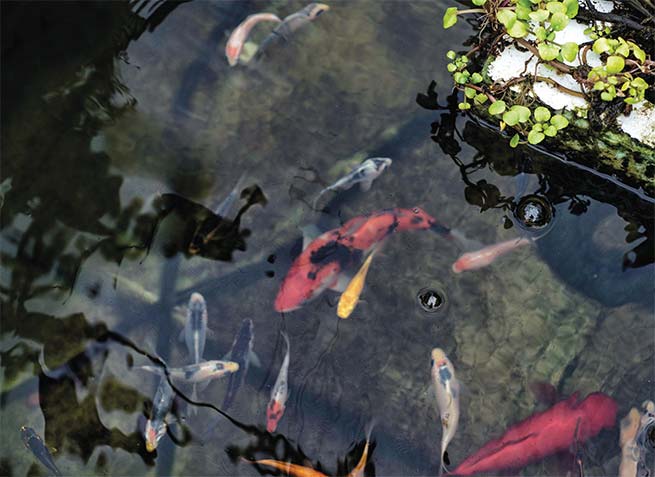
Goldfish start the aquaponics growing cycle at Profound Microfarms.
Photography by Teresa Rafidi
When Jeff Bednar first got interested in aquaponics in 2013, he and his three- and five-year-old daughters “built a countertop system with six goldfish and nine strawberry plants, which is how I got them interested.”
The real estate investor was looking for a sustainable way to grow food for his family. “We wanted to grow smart and not use a ton of water,” he says.
And when the strawberry plants blossomed and the fish thrived in the little countertop system, Bednar and his daughters were on top of the world, dancing and popping ripe strawberries into each other’s mouths and…
Not.
“We failed miserably,” Bednar says. “Everything died. After that, I realized I had a lot to learn.”
Today, he’s left real estate behind to develop his Profound Microfarms in Lucas into a commercial aquaponics farm, growing lettuces, herbs and more. The farm already grows enough to sell at the Four Seasons-Hebron and Weston farmers markets. Why are Bednar and other early adopters so passionate about aquaponics?
“It truly is the ecologically correct way to grow healthy foods,” says David Cohen, part of the duo that owns DFW Aquaponics Farms in Burleson. “It uses 90 percent less water than conventional farming, a minimum amount of utilities and can be done in an urban environment—a warehouse, a (defunct) gas station. We build on top, so we can use very inexpensive land.”
When you go to the farmers market—and even some grocery stores—produce grown aquaponically (or hydroponically) often is marketed as “living lettuce” and herbs because the roots are still attached. Whoa. What did you say? Hydroponics? Aquaponics? The same thing? Different? Most of us haven’t a clue.
“Aquaponics is the combination of aquaculture—fish farming— and hydroponics—growing things without soil,” says Cohen, step-ping back to offer the standard definition. Hydroponics is growing plants in water to which nutrients are added. At DFW Aquaponics, Cohen and partner Loretta Messinger teach people how to build their own aquaponics systems. They grow enough lettuce, greens and herbs to sell at the Tyler Street and Grand Prairie farmers markets.
“This is DIY,” he says, as we walk through his two greenhouses on a scruffy rural patch near Burleson. “One of the things we teach is how to build greenhouses. We want people to know that you don’t need a lot of money.”
DFW Aquaponics Farms and Profound Microfarms are two North Texas operations that show what’s possible with aquaponics, whether you’re looking for a new business or just want an efficient home setup. Large or small, the systems work essentially the same way (but there are lots of variations on the theme).
To begin with, there’s no scraping sludge from the bottom of the fish tanks, as I first wondered. These are closed-loop, circulating systems. They use gravity to get water from one point to the next, starting at the fish tanks. Enriched with fish waste, the water in the tank “overflows and goes to the swirl filter,” says Jay Lamb, a North Texas aquaponics pioneer who guided Bednar through the development of his system and consults at the farm.
Enriched with fish waste, the water in
the tank “overflows and goes to the swirl
filter.” — Jay Lamb, aquaponics pioneer
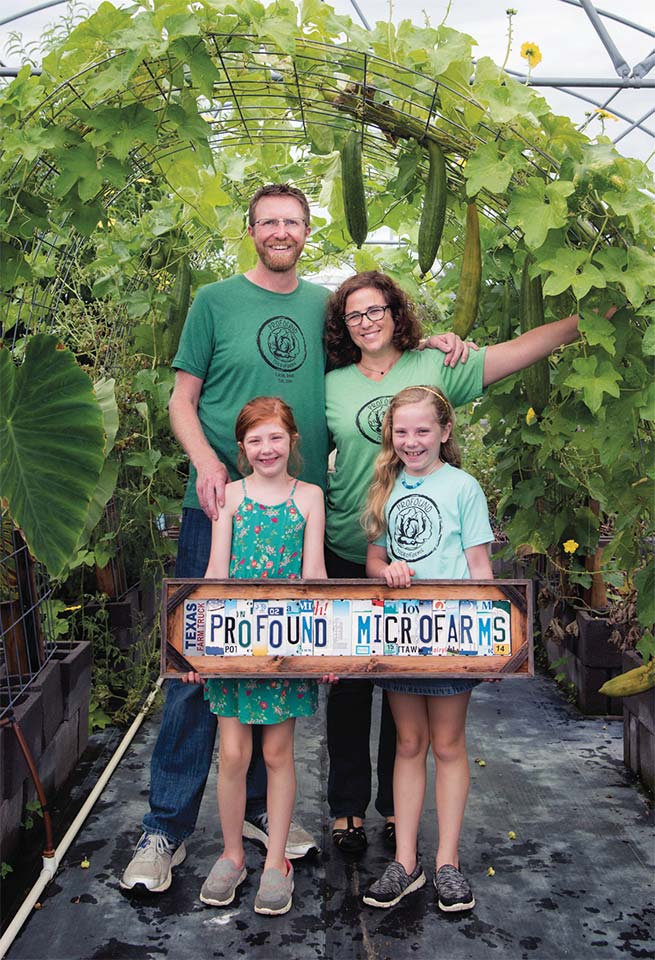
Jeff Bednar, with wife Lee and daughters (from left) Josephine and Lily,
started Profound Microfarms, which includes his wife’s non-aquaponic raised beds.
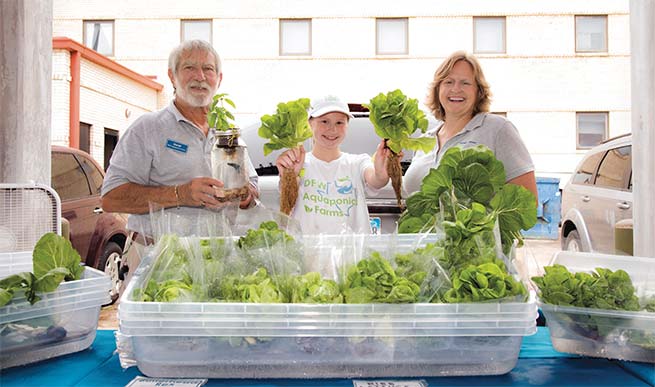
David Cohen and Loretta Messinger bring their DFW Aquaponics
Farms lettuces to Grand Prairie Farmers Market. Her daughter, Lizzy, likes to help.
With Bednar out of town, Lamb’s the one showing me through Profound Microfarms’ operation. Unlike DFW Aquaponics, these greenhouses sport concrete floors and evaporative coolers running the full length of one wall (more about this in a moment). Chickens gambol outside the greenhouses, and rabbits cavort in a nearby run. One greenhouse serves as an experimental facility. One houses organic, raised-bed gardens. And the most recently refurbished one is gearing up with hydroponic ponds as a step toward fish to come. Before Bednar bought them, these greenhouses were used to grow orchids.
Back to the aquaponics cycle: Naturally occurring bacteria ultimately convert the fish waste/ammonia to nitrates—pure nutrients to feed the plants. Using gravity, the water flows into the ground-level troughs, roughly a foot deep, lined in plastic and covered with floating foam rafts. The rafts have tiny holes in them several inches apart into which seedlings ranging from lettuce to tomatoes are “planted.” The roots seek and find nutrients in the water. As they take up the nutrients, they in turn purify the water. When the water flows out of the last trough—a system could have one or several—a small pump sends it back uphill to the fish tank, where the cycle starts again.
“The larger the system, the easier it is to maintain,” Bednar says in a phone interview. “That’s because it’s a bigger body of water so there’s less temperature fluctuation.” The tanks must maintain a constant temperature. “Happy fish equal happy plants.”
“We have goldfish, catfish and tilapia,” says Cohen with DFW Aquaponics. Profound Microfarms uses tilapia, goldfish and koi.
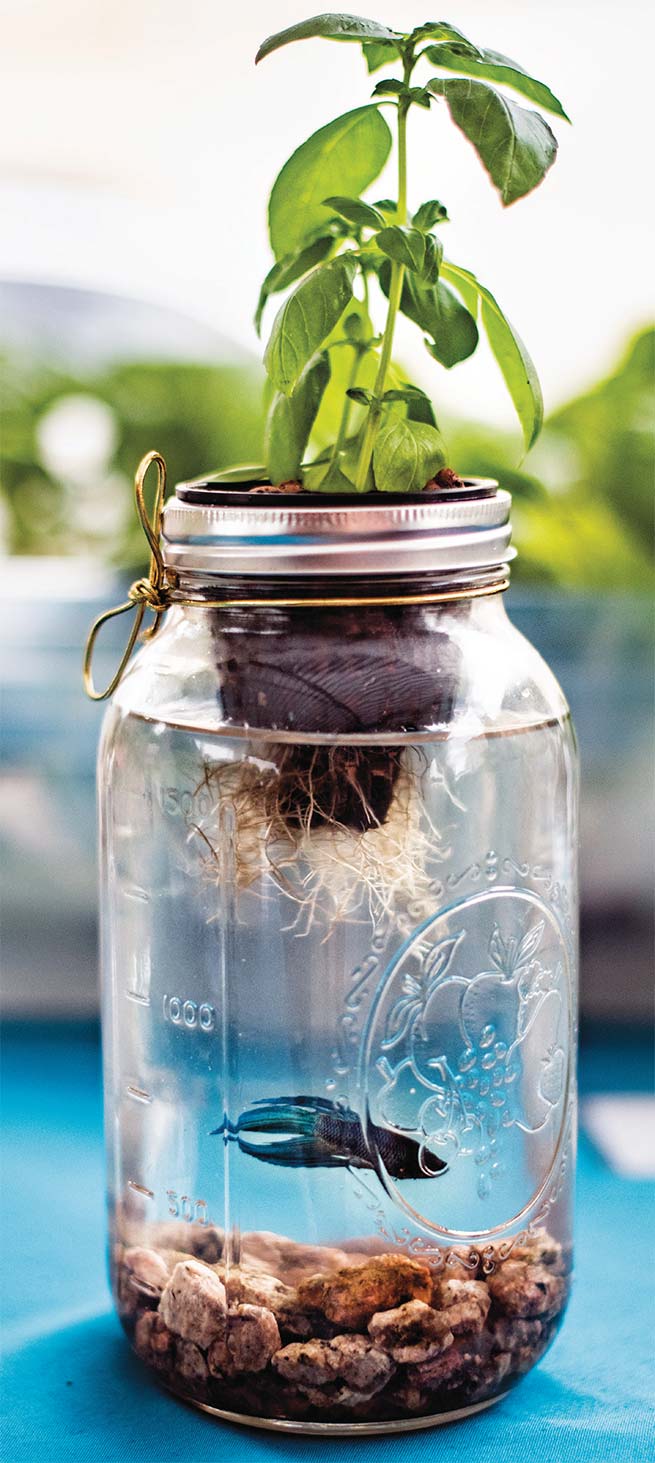
Don’t try this at home. David Cohen brings this miniature set-up
in a mason jar with a beta to show how aquaponics works
With Bednar out of town, Lamb’s the one showing me through Profound Microfarms’ operation. Unlike DFW Aquaponics, these greenhouses sport concrete floors and evaporative coolers running the full length of one wall (more about this in a moment). Chickens gambol outside the greenhouses, and rabbits cavort in a nearby run. One greenhouse serves as an experimental facility. One houses organic, raised-bed gardens. And the most recently refurbished one is gearing up with hydroponic ponds as a step toward fish to come. Before Bednar bought them, these greenhouses were used to grow orchids.
Back to the aquaponics cycle: Naturally occurring bacteria ultimately convert the fish waste/ammonia to nitrates—pure nutrients to feed the plants. Using gravity, the water flows into the ground-level troughs, roughly a foot deep, lined in plastic and covered with floating foam rafts. The rafts have tiny holes in them several inches apart into which seedlings ranging from lettuce to tomatoes are “planted.” The roots seek and find nutrients in the water. As they take up the nutrients, they in turn purify the water. When the water flows out of the last trough—a system could have one or several—a small pump sends it back uphill to the fish tank, where the cycle starts again.
“The larger the system, the easier it is to maintain,” Bednar says in a phone interview. “That’s because it’s a bigger body of water so there’s less temperature fluctuation.” The tanks must maintain a constant temperature. “Happy fish equal happy plants.”
“We have goldfish, catfish and tilapia,” says Cohen with DFW Aquaponics. Profound Microfarms uses tilapia, goldfish and koi.
“The first evidence of aquaponics was the
Aztecs, who built floats in the middle of
their lakes to plant crops and keep them
away from animals.” —David Cohen
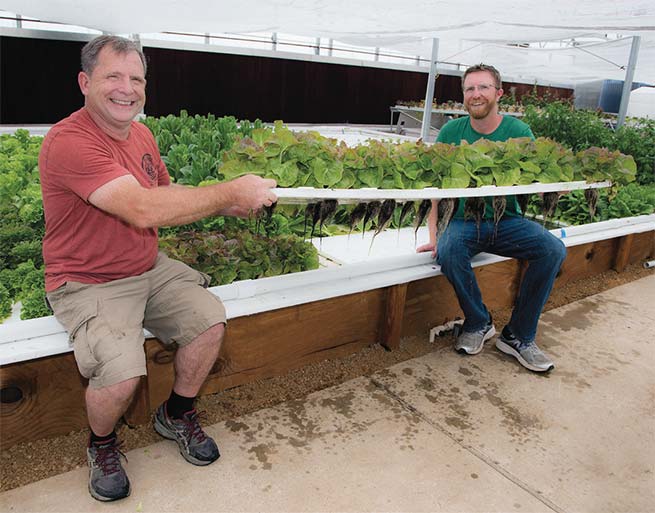
Jay Lamb (left), who helped design Profound Microfarms,
and Jeff Bednar lift up a foam raft to show how the lettuce
roots reach down into the nutrient-rich water.
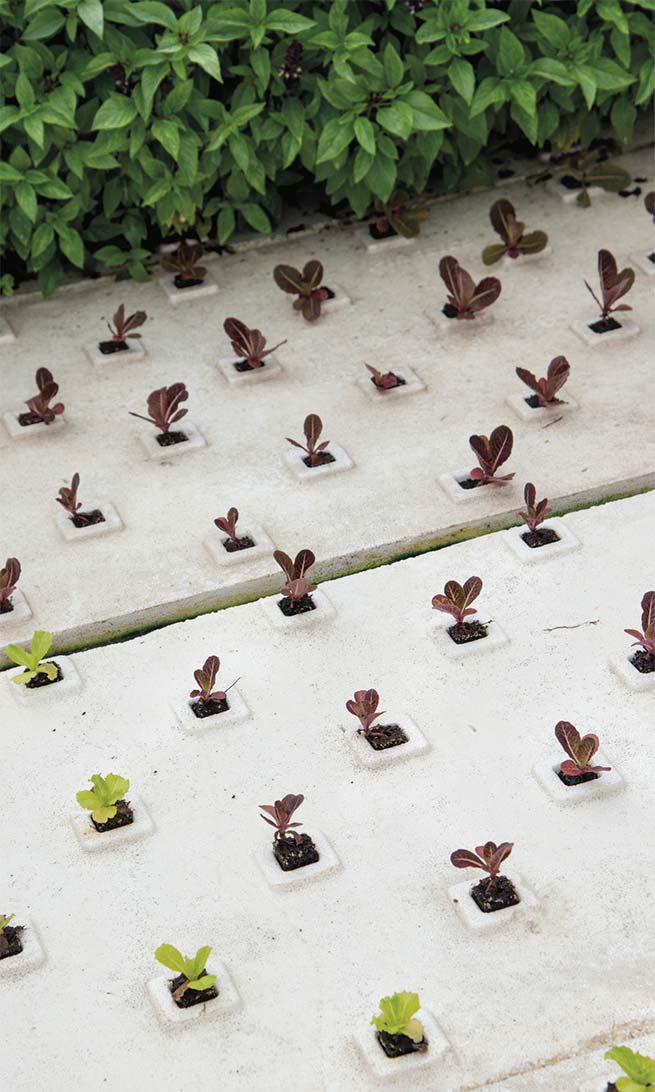
Seedlings are “planted” in the rafts.
But his girlfriend threw down a gauntlet: She didn’t want to get her nails dirty. So Lamb was determined to “find a way to garden where I don’t have to pay for her pedicures.” He built his first system on his apartment balcony. Since moving to Carrollton, where he’s a Medicare insurance consultant, he’s experimented with aquaponics in his backyard before moving the bulk of his system to Profound Microfarms. One thing that helped, besides his penchant to tinker: “As a kid, my dad had fi sh. I’ve bred Siamese fighting fish and angels. I had aquariums as a young adult.”
AT DFW Aquaponics, Cohen and Messinger complement each other. “She’s the green thumb,” he says. “I build and teach.” Cohen’s a former building contractor who got hooked on aquaponics through his son. “He went to Texas A&M where he got degrees in marine fi sheries and biology.” He started Green Phoenix Farms, the predecessor to DFW Aquaponics Farms, prior to moving to New Mexico.
Messinger’s the plant person. “I actually saw it (aquaponics) six years ago on Pinterest,” she says. “Aqua-what? I love fi sh—I always had aquariums—and I love to garden. I built my fi rst system at home. Th en I found out about Green Phoenix…. Last April was the fi rst meeting for this project.” She was laid off last year and since then has thrown herself into DFW Aquaponics. “I feel like this is what I was meant to do.”
In water-strapped Texas, it’s not far-fetched to say aquaponics may be one solution for growing healthy food sustainably in the future. “When I had a traditional garden,” Lamb says, “I paid $100 a month (water bill) to keep the weeds alive.” He paid for his fi rst system with the money he saved on water. And pedicures.
More about area aquaponics
DFW Aquaponics Farms will off er a three-month course this fall covering how to build a complete small system. Also holds monthly open houses. Sells produce at Grand Prairie and Tyler Street (Dallas) farmers markets.
Jeff Bednar at Profound Microfarms is developing an Urban Farm Academy to teach urban farming—not just aquaponics, but raised beds, rooft op farms and hydroponics. Also planned: how to market and sell what you grow. Sells at Four Seasons- Hebron and Weston farmers markets.
East Texas Aquaponics in Mineola off ers tours and classes. Sells at the Rockwall, Dallas (Sunday) and Winnsboro farmers markets. Easttexasaquaponics.com
Mineral Wells Aquaponics in Mineral Wells. Sells at Cowtown Farmers Market in Fort Worth. Facebook: Mineral Wells Aquaponics
KIM PIERCE is a Dallas freelance writer and editor who’s covered farmers markets and the locavore scene for some 30 years, including continuing coverage at The Dallas Morning News. She came by this passion writing about food, health, nutrition and wine. She and her partner nurture a backyard garden (no chickens – yet) and support local producers and those who grow foods sustainably. Back in the day, she co-authored The Phytopia Cookbook and more recently helped a team of writers win a 2014 International Association of Culinary Professionals Cookbook Award for The Oxford Encyclopedia for Food and Drink in America.
- Kim Piercehttps://www.edibledfw.com/author/kpierce/
- Kim Piercehttps://www.edibledfw.com/author/kpierce/
- Kim Piercehttps://www.edibledfw.com/author/kpierce/
- Kim Piercehttps://www.edibledfw.com/author/kpierce/







